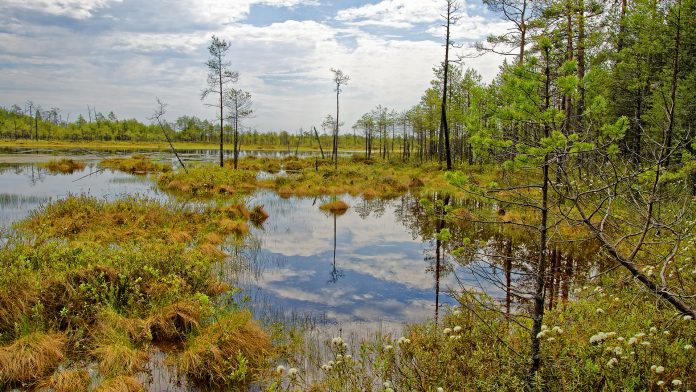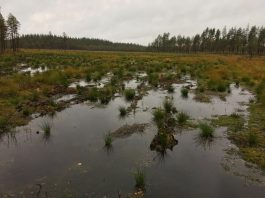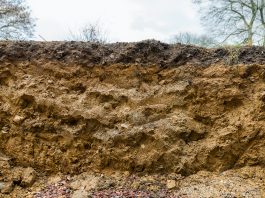Researchers with the Ecohydrology Research Group (ERG) are interested in understanding and predicting how northern peatlands respond to anthropogenic disturbances, land-use changes, and climate warming.
Peatlands are a valuable but vulnerable natural resource. Peat forms through the slow accumulation of partially decomposed plant biomass in water-saturated soils of wetlands across the boreal and taiga ecoregions, as well as in cool temperate and tropical locations. Peatlands are transitional environments between land and water (Fig. 1): their hydrological, ecological, and biogeochemical functions support a variety of ecosystem services, including biodiversity conservation, water quality protection and climate regulation. While peatlands cover only about 3% of the continents (Fig. 2), they are estimated to store on the order of 10% of all freshwater and approximately 30% of land-based organic matter.
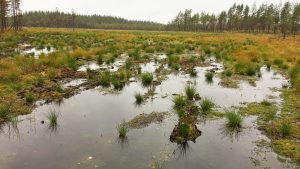
Northern peatlands are attracting particular attention because high latitude regions are warming faster than the global average. This creates the conditions for increasing carbon dioxide (CO2) and other greenhouse gas (GHG) emissions from peat soils, further accelerating global climate change. Another consequence of climate warming is the enhanced leaching of dissolved organic matter (DOM) from peatlands with far-reaching consequences for the water quality, optical properties, thermal regimes, and trophic state of receiving streams, lakes and nearshore coastal areas.
How peatlands respond to environmental change
Researchers with the Ecohydrology Research Group (ERG) are interested in understanding and predicting how northern peatlands respond to anthropogenic disturbances, in particular, land-use changes and climate warming. Their research is helping to unravel the coupling of pore-scale soil processes and functions to hydrological and climate drivers acting at local and regional scales such as wetland drainage, freeze–thaw cycles, and changes in the extent and depth of snow cover. The process-level knowledge and data are then scaled-up using modelling approaches, including Machine Learning algorithms, to forecast possible future trajectories of peatlands under various scenarios of environmental change.
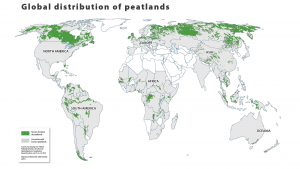
Compared to most mineral soils, peat soils are highly structured and complex porous media, with unique physical, geochemical, thermal, and hydraulic properties (Fig. 3). The structure of peat soil consists of pores that are open and connected, dead-ended, or isolated. The multi-porosity nature of peat soils affects water flow and retention that, in turn, influence the fate and transport of carbon, nutrient elements, GHGs and contaminants. In particular, the larger pores (the mobile porosity) actively participate in macroscopic pore water flow and relatively fast advective chemical transport, and smaller pores (the immobile porosity) that exchange solutes with the mobile porosity through slower, short-range molecular diffusion. At ERG, we use chemical tracers, for example deuterated water (also known as heavy water), to probe the relationships between transport processes and pathways, on the one hand, and chemical transport, on the other hand.
Understanding the structure and properties of peat soils
The immobile regions within peat are the primary sites where microbially mediated biogeochemical transformation processes take place. These transformation processes are driven by the decomposition of the peat, which under water-saturated conditions is very slow because of the absence of molecular oxygen (O2). The microorganisms responsible for decomposing the organic compounds that make up the peat must therefore rely on less powerful oxidants than O2, or on fermentation. In addition, the supply of these alternative oxidants, but also the removal of the decomposition by-products, for example CO2 and methane (CH4), are hampered by the slow diffusional exchanges between the immobile and mobile porosity. To better understand how the pore structure and transport properties of peat soils control their biogeochemical activity, ERG researchers combine geochemical, isotopic, and genetic analyses with X-ray tomography imaging and tracer experiments.
Undisturbed peatlands produce more plant biomass than is decomposed belowground. As a result, peat accumulation represents a net sink of atmospheric CO2. Human perturbations of peatlands, however, can shift this CO2 balance in the opposite direction. A prime example is the drainage of peatlands for their use in agriculture. As the water table is drawn down, the peat is exposed to air, causing the accumulated organic material to be oxidized by O2 and generating CO2 that is emitted to the atmosphere. Therefore, the drained peat soils now become a source of CO2, enhancing the radiative forcing of the atmosphere. Even in the absence of direct land-use changes, however, climate warming may turn northern peat deposits into GHG sources because of the melting of permanently frozen grounds (permafrost), enhanced wildfire activity, and changes in snow cover. At ERG, we are currently using Artificial Intelligence techniques to derive predictive algorithms from time series data and then we use global warming scenarios to project future peatland GHG emissions.
Another consequence of global warming is sea-level rise. Together with colleagues from the University of Rostock in Germany, we are investigating coastal peat deposits to determine the effects of freshwater-seawater tidal mixing and exposure to rising salinity on peat carbon dynamics. This collaborative work is motivated by the need to better predict the combined consequences of sea-level rise and land subsidence from wetland drainage that increasingly expose nearshore peatlands to seawater intrusion. In addition, we are assessing the potential of peat to attenuate the dispersion of agricultural and municipal pollutants.
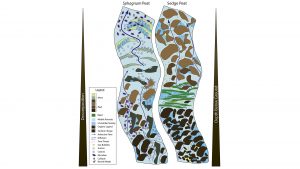
Overall, ERG’s research is advancing the quantitative understanding of the biogeochemical reactivity of peat under a broad range of environmental conditions. The resulting data and knowledge are the key to inform restoration and management practices that enhance the beneficial functions of peatlands, including their capacity to counteract rising atmospheric CO2 concentrations. Because of their great potential to contribute to nature-based solutions for climate change mitigation, the role of peatlands will be featured at the upcoming United Nations COP26 summit in Glasgow in November.
Read more:
Ackley, C., Tank, S.E., Rezanezhad, F., McCarter, C., and Quinton, W.L. (2021). Coupled hydrological and geochemical impacts of wildfire in peatland-dominated regions of discontinuous permafrost. Science of the Total Environment 782, 146841
Gharedaghloo B., Price J. S., Rezanezhad F., and Quinton W. L. (2018). Evaluating the hydraulic and transport properties of peat soil using pore network modeling and X-Ray micro computed tomography. Journal of Hydrology 561, 494-508
Gosh, L., Townsend, H., Kreuzberg, M., Janssen, M., Rezanezhad, F., and Lennartz, B. (2019) Sulfate mobility in fen peat and its impact on the release of solutes. Frontiers in Environmental Science 7, 189
Kleimeier, C., Rezanezhad F., Van Cappellen P., and Lennartz B. (2017). Influence of pore structure on solute transport in degraded and undegraded fen peat soils. Mires and Peat
Kreuzburg, M., Rezanezhad, R., Milojevic, T., Voss, M., Gosch, L., Liebner, S., Van Cappellen, P., and Rehder, G. (2020). Carbon release and transformation from coastal peat deposits controlled by submarine groundwater discharge: A column experiment study. Limnology and Oceanography 65, 1116-1135
Liu, H., Zak, D., Rezanezhad, F. and Lennartz, B. (2019). Soil degradation determines release of nitrous oxide and dissolved organic carbon from peatlands. Environmental Research Letters 14, 094009.
Liu, H., Price, J., Rezanezhad, F. and Lennartz, B. (2020). Centennial-scale shifts in hydrophysical properties of peat induced by drainage. Water Resources Research 56 , e2020WR027538.
Liu, H., Rezanezhad, F., Lennartz, B. (2022). Impact of land management on available Water capacity and water storage of peat soils. Geoderma 406, 115521.
McCarter, C., Rezanezhad, F., Gharedaghloo, B., Price, J., and Van Cappellen, P. (2019). Transport of chloride and deuterated water in peat: The role of anion exclusion, diffusion, and anion adsorption in a dual porosity organic media. Journal of Contaminant Hydrology 225, 103497.
McCarter, C.P.R., Rezanezhad, F., Quinton, W.L., Gharedaghloo, B., Lennartz, B., Price, J., Connon, R., and Van Cappellen, P. (2020). Pore-scale controls on hydrological and geochemical processes in peat: Implications on interacting processes. Earth-Science Reviews 207, 103227.
Pi, K., Bieroza, M., Brouchkov, A., Anatoli, C., Chen, W., Dufour, L., Gongalsky, K.B., Herrmann, A., Krab, E., Landesman, C., Laverman, A., Mazei, N., Mazei, Y., Peichl, M., Öquist, M., Pozdniakov, S., Rezanezhad, F., Roose-Amsaleg, C., Shatilovich, A., Shi, A., Smeaton, C.M., Tong, L., Tsyganov, A.N., Van Cappellen, P. (2021). The cold region critical zone in transition: Responses to climate warming and land use change. Annual Review of Environment and Resources 46, 111-34.
Rafat, A., Rezanezhad, F., Quinton, W. L., Humphreys, E. R., Webster, K., Van Cappellen, P. (2021). Non-growing season carbon emissions in a northern peatland are projected to increase under global warming. Communications Earth & Environment, 2, 111.
Rezanezhad, F, Price J.S., Quinton W.L., Lennartz B., Milojevic T., and Van Cappellen P. (2016). Structure of peat soils and implications for water storage, flow and solute transport: A review update for geochemists. Chemical Geology 429, 75-74.
Rezanezhad F., Kleimeier C., Milojevic T., Liu H., Weber T. K. D., Van Cappellen P., and Lennartz B. (2017). The role of pore structure on nitrate reduction in peat soil: a physical characterization of pore distribution and solute transport. Wetlands 37, 951-960.
Rezanezhad, F., McCarter, C.P.R., and Lennartz, B. (2020). Editorial: Wetland Biogeochemistry: Response to Environmental Change. Frontiers in Environmental Science 8, 55.
Please note, this article will also appear in the eighth edition of our quarterly publication.

